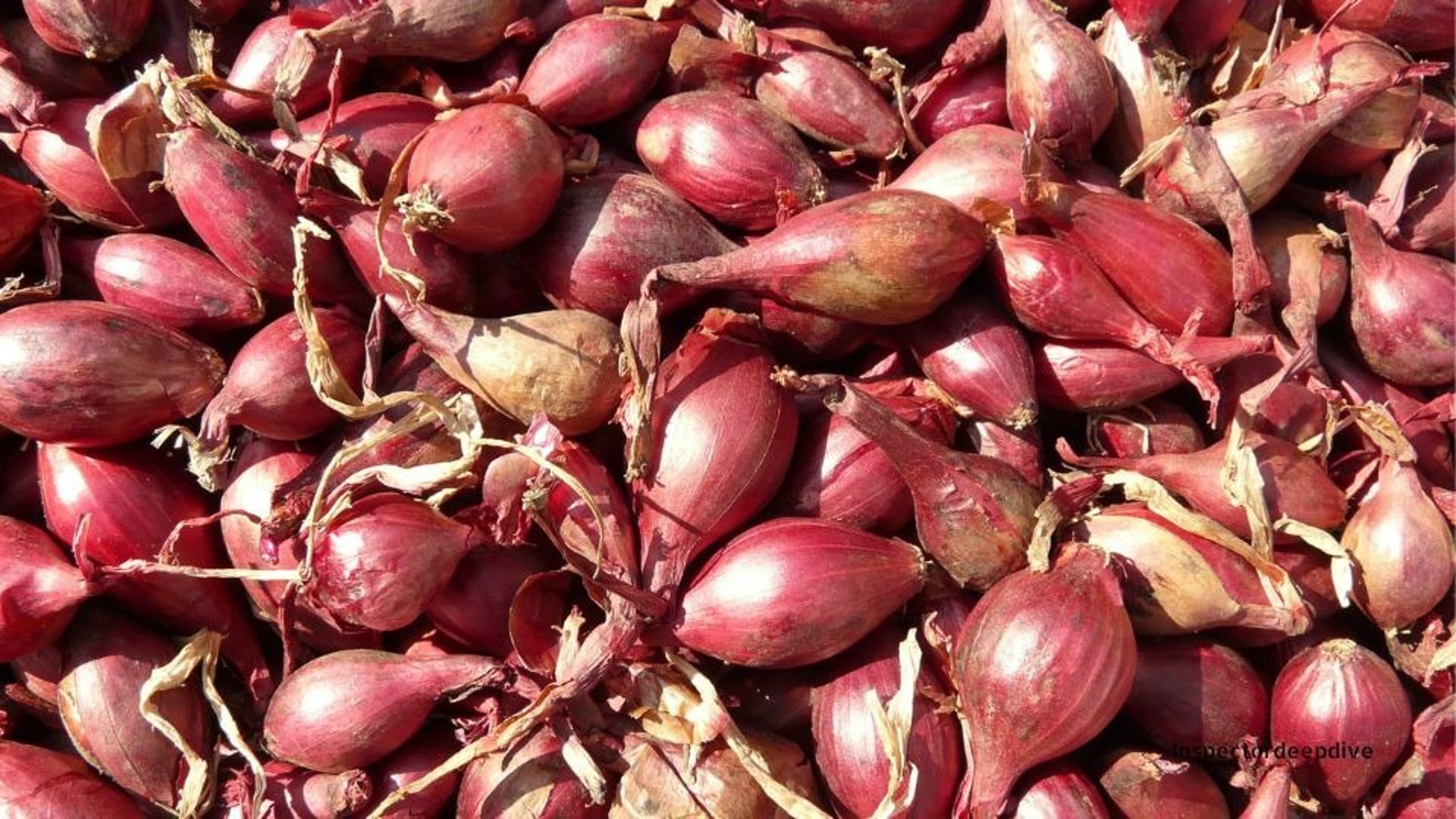
Shallot Nutrition Facts: Calories, Vitamins, Minerals, and Bioactives

Shallot Nutrition Facts: Calories, Vitamins, Minerals, and Bioactives
Allium cepa var. aggregatum, commonly known as shallot, is a botanical variant of onion with clustered bulbs and a distinct flavor profile. It belongs to the Allium family alongside onions, garlic, leeks, and chives and has been used in global cuisines for centuries.
This is not a claim of benefit or necessity.
It is an examination of what shallots contain and what science observes as of 2025.
Family Name, Origin, and Varieties
Family: Amaryllidaceae (formerly classified under Alliaceae)
Species: Allium cepa
Shallots are believed to have originated in Central and Southeast Asia, with historical cultivation documented in India, Myanmar, and Thailand. Unlike single-bulb onions, shallots grow in clusters resembling garlic cloves.
Common varieties include:
French Gray Shallot (Échalion de Jersey): Elongated shape, delicate taste.
Red Dutch Shallot: Rounder, deeper red skin, widely available commercially.
Jersey Shallot: Pear-shaped, coppery skin, prized in French cuisine.
Genetic studies (2024) confirm that shallots are a fertile clone group within Allium cepa, distinct from multiplier onions and garlic.
Seasonality & Availability
Shallots are cool-season crops, typically planted in fall or early spring and harvested between late spring and midsummer, depending on region.
Fresh shallots peak in availability from May to September in the Northern Hemisphere. However, due to global trade and storage capability (up to 2–3 months under proper conditions), they are accessible year-round in most markets.
Forms available:
Fresh whole
Dried powder
Pickled
Frozen
No seasonal nutritional differences have been consistently demonstrated.
Nutritional Breakdown: Shallots
(Raw, per 30g serving)
Energy (Calories): 22 kcal
Higher than common onions due to lower water content and higher carbohydrate concentration.Water: 24 g
Contributes to texture but less hydrating than high-moisture vegetables.Protein: 0.75 g
Contains essential amino acids in trace amounts; not a significant source.Total Fat: 0.03 g
Negligible lipid content.Saturated: 0.009 g
Monounsaturated: 0.006 g
Polyunsaturated: 0.012 g
Carbohydrates: 5.04 g
Primary macronutrient contribution.Dietary Fiber: 0.96 g
Balanced mix of soluble and insoluble fiber; supports fecal bulk and gut transit.Sugars: 2.37 g (fructose, glucose, sucrose)
Natural sugars increase slightly during storage and cooking.
Vitamins
Vitamin C: 2.4 mg (9% of 30 mg RDI*)
Antioxidant role; involved in collagen synthesis; degrades with heat and prolonged storage.Folate (B9): 19.2 µg (16% of 120 µg RDI)
Required for DNA replication and red blood cell formation; particularly relevant during growth phases.Vitamin B6 (Pyridoxine): 0.10 mg (17% of 0.6 mg RDI)
Supports amino acid metabolism and neurotransmitter production.Choline: 3.7 mg
Precursor for acetylcholine and phospholipids in cell membranes.No significant levels of vitamins A, D, E, K, or B12 detected.
Minerals
Potassium: 100 mg (7% of 1400 mg RDI)
Supports fluid balance, nerve signaling, and vascular regulation.Phosphorus: 16 mg (7% of 230 mg RDI)
Structural component of bones and ATP.Magnesium: 6.3 mg (5% of 125 mg RDI)
Cofactor in over 300 enzymatic reactions, including energy metabolism.Calcium: 11 mg (3% of 400 mg RDI)
Minor structural mineral contribution.Iron: 0.36 mg (7% of 5 mg RDI)
Non-heme iron; absorption influenced by dietary enhancers (e.g., vitamin C) and inhibitors (e.g., phytates).Zinc: 0.12 mg (4% of 3 mg RDI)
Supports immune function and enzyme activity.Also contains trace amounts of manganese, copper, selenium, and molybdenum.
Bioactive Compounds (Phytochemicals)
Flavonoids: Quercetin (especially quercetin-4'-glucoside), kaempferol
Concentrated in outer layers; studied for antioxidant effects in vitro and rodent models.Organosulfur Compounds: Allicin (when cut), thiosulfinates, sulfides
Formed upon tissue damage; responsible for pungency and studied for cellular protection mechanisms under lab conditions.Saponins: Present in measurable amounts
Foaming compounds investigated for cholesterol-binding potential in controlled settings.
How Shallots Affect the Body
When consumed raw or lightly cooked, shallots release volatile sulfur compounds such as allicin, which degrade rapidly. These compounds show free radical scavenging ability in test tubes and animal models.
Fiber content may support microbial fermentation in the colon, contributing to short-chain fatty acid production.
Quercetin has been studied for anti-inflammatory pathways in isolated cells. Human trials show inconsistent bioavailability and no confirmed systemic effect at dietary doses.
No clinical evidence demonstrates that consuming shallots alters disease risk, metabolic markers, or organ function in healthy individuals.
Culinary Use and Preparation
Shallots are used raw in vinaigrettes, sauces, and garnishes, or cooked in sautés, roasts, and reductions. Their milder, sweeter profile compared to yellow onions makes them preferred in fine cuisine.
Cutting triggers enzymatic reactions that produce volatile sulfur compounds causing eye irritation (lachrymatory factor).
Cooking reduces pungency and alters chemical composition, particularly flavonoid and sulfur compound stability.
Safety Notes
Generally safe for most individuals.
May cause gastrointestinal discomfort in sensitive people (e.g., IBS).
Can exacerbate heartburn in those with GERD.
Allergic reactions are rare but documented.
No toxicity concerns at culinary doses.
Scientific Research (2024–2025)
Studies are exploring:
Bioavailability of quercetin from allium matrices.
Role of shallot extracts in natural food preservation systems.
Observational links between allium vegetable intake and metabolic markers in diverse populations.
No large-scale human intervention trials confirm functional health benefits.
Conclusion
Shallots are a low-volume, nutrient-dense vegetable with measurable fiber, folate, vitamin B6, iron, and bioactive compounds like quercetin and organosulfur molecules. They contribute flavor complexity and dietary diversity.
They are not required in the diet.
No unique physiological role has been established.
But within varied eating patterns, they represent one of many plant-based sources of micronutrients and phytochemicals.
As research progresses, their presence will be clarified not promoted.
© 2025 food.InspectorDeepDive.com. All rights reserved. Content may not be copied or republished without permission.
This article is for informational purposes only. InspectorDeepDive.com does not provide medical advice. Always consult a licensed healthcare provider before making dietary or health decisions.
